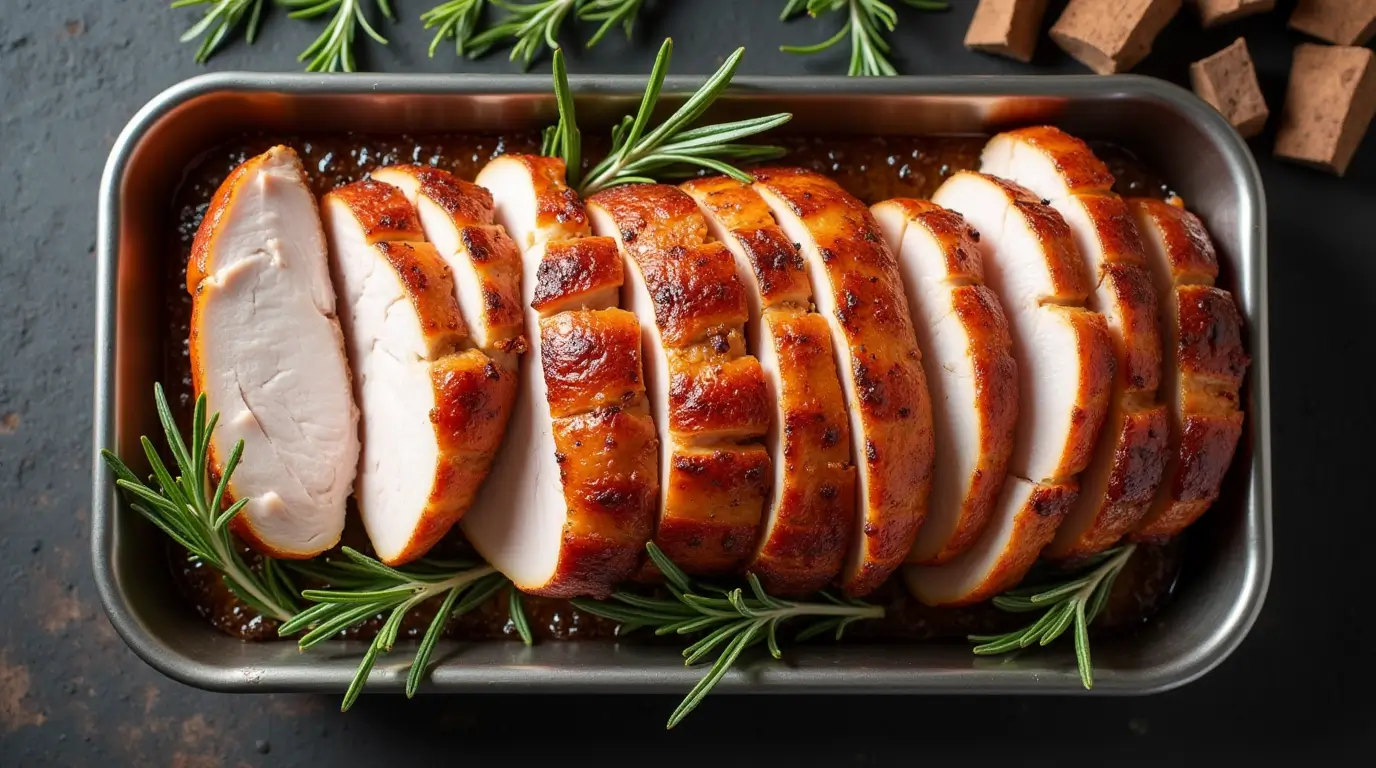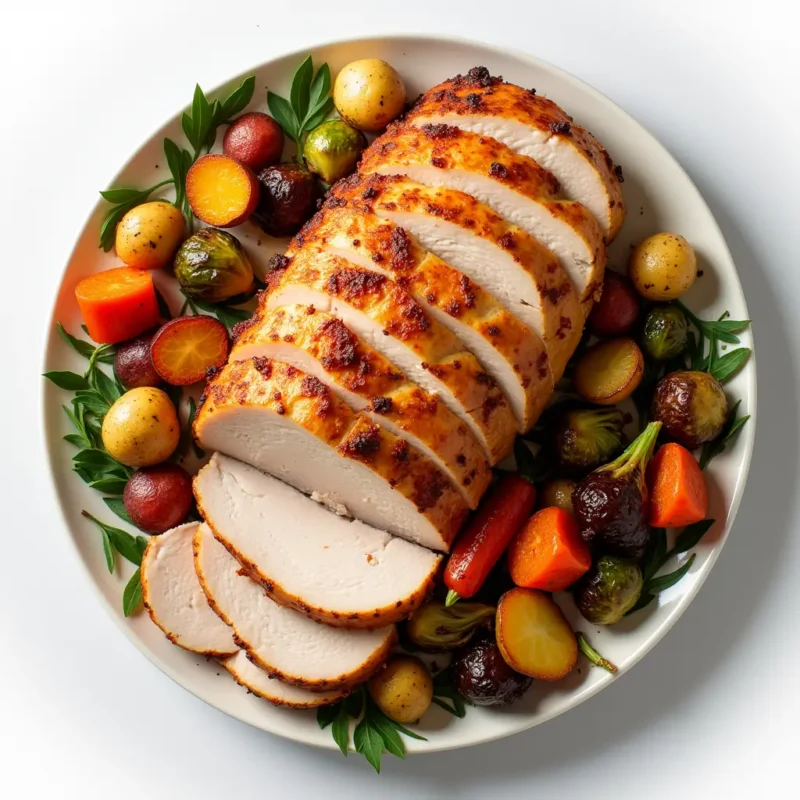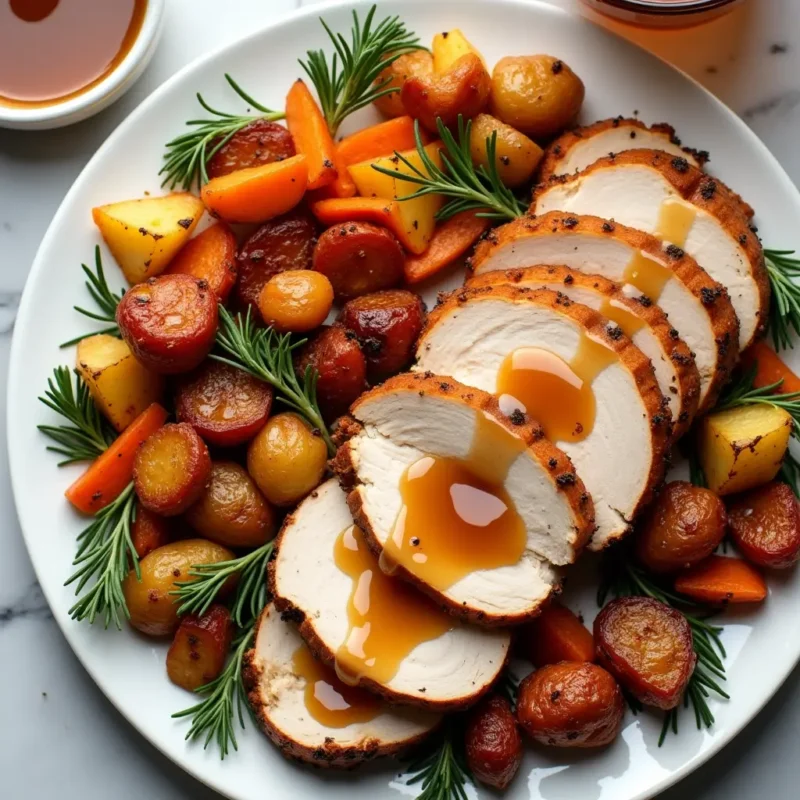Smoked turkey breast is often overlooked but can be as good as ribs or brisket. It’s not true that turkey breast always ends up dry. With the proper methods, you can make it juicy and tender.
This method makes your turkey breast taste like it’s from a restaurant. It turns a bland dish into a favorite.
Key Takeaways
- USDA guidelines require reaching 165°F (73.9°C) internal temp for safe eating.
- Smoke at 215°F–235°F to prevent overcooking and maintain moisture.
- Brining in a salt-sugar cure (73g salt + 43g Cure #1) boosts flavor and tenderness.
- A 6-pound turkey breast takes 3 hours at 30 minutes per pound.
- Offers 43g protein and 274 calories per serving, perfect for meal prep.
Why Smoked Turkey Breast Is a Game-Changer for Your Menu
Smoked turkey breast has a turkey breast flavor that makes dishes better. It’s not dry or bland like some proteins. Smoking adds a smoky taste that goes well with its juices.
Using applewood or hickory makes it even tastier. This method is better than grilling or roasting.
The Flavor Profile You Can’t Get Any Other Way
Smoke makes turkey breast a healthy smoked meat that’s both smoky and tender. Trying different woods like cherry or mesquite adds more flavor. For example:
- Applewood: subtle sweetness
- Hickory: bold, robust notes
- Cherry: mild fruity undertones
Health Benefits of Smoking vs. Other Cooking Methods
Smoking keeps more low-fat protein than frying or pan-searing. It’s better than deep-fried turkey because it’s lower in calories. It also stays moist.
Here’s how it compares:
| Cooking Method | Fat Content | Flavor |
|---|---|---|
| Smoking | Low natural fat | Deep, smoky notes |
| Frying | High added fats | Greasy, heavy taste |
When to Serve Smoked Turkey Breast Beyond Thanksgiving
Smoked turkey is good all year, not just for holidays. You can put it in sandwiches, salads, or grain bowls. It’s great for dinner or picnics.
It’s also good for leftovers. You can keep it in the fridge for 3–4 days. It’s perfect for meal prep.
Essential Equipment for Smoking the Perfect Turkey Breast
Mastering smoked turkey breast starts with the right gear. Whether you’re a seasoned pitmaster or a beginner, these tools ensure consistent results:
| Smoker Type | Pros | Cons |
|---|---|---|
| Pellet (Traeger) | Automated temp control | Higher cost |
| Electric (Weber SmokePro) | User-friendly operation | Less smoke flavor |
| Propane (Weber Summit) | Portable and efficient | Requires fuel |
| Charcoal (Weber kettle) | Affordable smoke flavor | Requires monitoring |
Smoker types for turkey all work well—choose based on your setup. Next, meat thermometers are non-negotiable. Pro chefs swear by Thermopen or Thermopro TP075 models. A water pan for smoking placed under the meat traps drippings and adds humidity. Pair this with wood chips like hickory or apple for rich flavor.
- Water pans (stainless or disposable)
- Aluminum foil for wrapping (foil wrap at the end prevents drying)
- Leave-in thermometers like the Brinkmann Digital Probe
- Spray bottles for misting
80% of home cooks rely on meat thermometers to ensure the turkey reaches 165°F, according to a recent survey.
Invest in smoking accessories like turkey racks for even heat distribution. For budget setups, a charcoal kettle with a digital probe and foil pan works perfectly. Prioritize accuracy over complexity—the right tools turn every attempt into a success.
Preparing Your Turkey Breast for the Smoker
Getting your turkey breast ready is important. It makes it moist and tasty. Follow these steps to pick, brine, season, and truss your turkey.
Selecting the Right Size and Quality
Choose a turkey breast that’s 1.5 to 2 pounds. You can pick bone-in or boneless. But bone-in is better for flavor. A 2-pound breast feeds about 4 people.
Look for meat that’s plump and has no bruises. Always choose fresh, unthawed turkey for the best taste.
Brining: The Secret to Moisture Retention
Brining makes your turkey juicy. For a turkey breast brine, mix these in a big bowl:
- 12 cups cold water
- ½ cup Diamond Crystal kosher salt
- ½ cup dark brown sugar
- 8 garlic cloves (crushed)
- 2 rosemary sprigs
- 10 peppercorns
- 2 bay leaves
- 1 lemon and 1 orange, sliced
- 1 cup white wine
- 2 cups ice
Put the turkey in the brine and chill for 12–24 hours. For dry brining turkey, rub it with 5 tsp Morton’s kosher salt. Then, chill it uncovered overnight.
Dry Rub Recipes That Enhance Smoky Flavors
A turkey dry rub recipe makes it smoky. Try this mix:
- ½ tbsp garlic salt
- 1 tsp onion powder
Put the rub on the turkey before smoking. Add smoked paprika or cayenne for spice.
Trussing Techniques for Even Cooking
Trussing helps cook the turkey evenly. Use twine to tie the breast into a tight shape. This is key for bone-in breasts.
The Complete Smoked Turkey Breast Process
Mastering smoked turkey breast needs careful steps. Follow these for great results:
Setting Up Your Smoker for Poultry
Put the turkey breast on the smoker grate, away from the flame. Add a water pan to keep things moist and stable. Use a digital thermometer to check the smoking turkey temperature. Keep it between 225°F and 275°F. Pellet smokers do best at 250°F for good smoke.
Temperature Control Throughout the Smoke
Keep the smoking turkey temperature steady with these tips:
- Adjust vents to control airflow and heat
- Check temperature every 30 minutes
- Don’t open the smoker lid too often
A 2-3 lb turkey breast at 250°F takes about 3 hours. But, use internal temperature guidelines more than turkey smoking time.
Wood Chip Selection for Optimal Flavor
Pick mild wood chips for turkey like apple, cherry, or pecan. Stay away from strong woods like mesquite. Soak chips 30 minutes before to make smoke last longer. Pecan pellets give a sweet, nutty taste that’s great for poultry.
How to Tell When Your Turkey Breast Is Done
Put a meat thermometer into the thickest part, but not touching bone. Aim for internal temperature guidelines of 157°F to 160°F. It will get to 165°F while resting. Rest for 15-20 minutes before slicing to keep juices in. Look for opaque flesh and clear juices when you pierce it.
Troubleshooting Common Smoking Issues
Mastering smoked turkey breast means knowing how to fix unexpected problems. Here’s how to tackle four common issues:
- Turkey breast too dry: Pull the meat 5-7°F before 165°F. Wrap it in foil with a sprinkle of broth at 148°F to keep juices in. A water pan in the smoker helps keep moisture in.
- Fixing rubbery skin: Heat up to 300°F for the last 15 minutes to crisp the skin. Don’t over-brine—3-6 hours is enough. After smoking, broil the skin for 2-3 minutes under the oven’s broiler.
- Smoking temperature issues: Use a remote probe thermometer in the thickest part. For uneven temps, check the charcoal or wood levels. Keeping the smoker at 275°F helps cook evenly.
- Uneven cooking: Turn the breast every 45 minutes. Use butcher’s twine to tie thin edges to cook evenly. Place thicker parts closer to the heat.
Always use a water pan to keep moisture in. Use dual probes—one for the turkey, one for the smoker. Adjusting these methods keeps meat juicy and skin crispy. Turkey is safe at 157°F, but aim for 160-165°F for tenderness.
FAQ
Can I smoke a turkey breast without a traditional smoker?
Yes, you can smoke a turkey breast in a gas grill or electric oven. Just use smoking chips in a foil pouch. Keep the temperature and smoke right for the best flavor.
What are the best wood chips to use for smoking turkey breast?
Apple, cherry, pecan, and oak wood chips are great for turkey. They add a mild flavor that goes well with turkey without being too strong.
How do I prevent my turkey breast from being dry after smoking?
To avoid dryness, brine the turkey first. Watch the internal temperature closely. Use a moisture pan in your smoker. Cook to 157-160°F and let it rest before serving.
What is the recommended serving size for smoked turkey breast?
Plan for 1/2 pound of turkey per person. This makes sure everyone gets enough, which is important at parties.
How long does it take to smoke a turkey breast?
Smoking a turkey breast takes about 30-45 minutes per pound at 250°F. Always check the internal temperature to make sure it’s at least 165°F.
Are there any creative ways to use leftover smoked turkey breast?
Yes! You can use leftover turkey in sandwiches, salads, soups, and casseroles. It’s a great way to enjoy the smoky flavor in many meals.
What should I look for when selecting a turkey breast at the store?
Choose a fresh or thawed turkey breast. It should be moist and plump, without any bad smells. Bone-in breasts are usually better at keeping moisture.
How can I enhance the flavors of my smoked turkey breast?
Use a flavorful dry rub or marinade before smoking. Mix herbs, spices, and citrus for a tasty blend. Brining also adds great flavor and keeps the meat moist.
Conclusion: Elevating Your Cooking Game With Perfectly Smoked Turkey
Learning to smoke turkey breast opens up a world of taste and options. It’s great for holidays or just a regular dinner. The turkey turns out tender and full of smoky flavor.
First, let the turkey rest to keep the juices in. Serve it with creamy mashed potatoes or fresh green beans. Don’t forget to make a homemade gravy with the drippings and cornstarch.
Leftover turkey is a treasure trove of recipes. Make tasty sandwiches with sharp cheddar and slaw, or shred it for soups and salads. Keep leftovers in a tight container for up to four days or freeze them for later.
For beginners, start with a 5- to 6-pound breast. Smoke it at 225°F for 3-4 hours. Always use a digital thermometer to check the turkey’s internal temperature, which should be 165°F.
Start small and follow food safety rules to avoid problems. Even new cooks can wow their guests with this method. Try different dry rubs like paprika and thyme to make the turkey even more special.



